Summer field course centers the history, culture and experiences of Native students
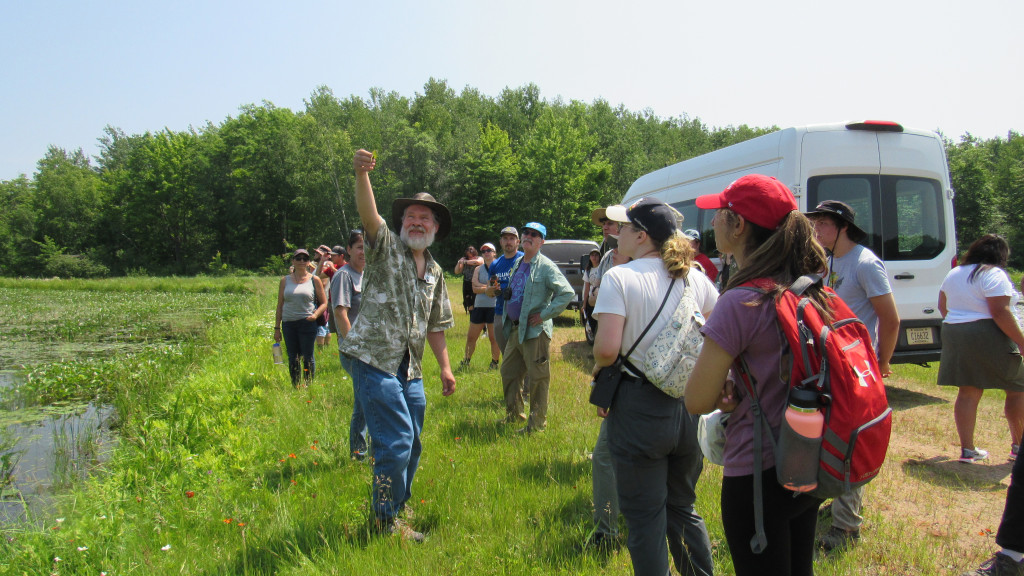
Mike Heim, a Lac Courte Oreilles Ojibwe University science faculty member specializing in horticulture, demonstrates the translucent qualities of aquatic vegetation during a visit to the Lac Courte Oreilles manoomin (wild rice) restoration research ponds. Maria Moreno
HAYWARD – On a warm June afternoon, students in a field course hosted by Lac Courte Oreilles Ojibwe University navigated the waters of the Chippewa Flowage in pontoon boats, witnessing firsthand both the majesty of soaring eagles and the impacts of water erosion on the hundreds of tree-covered islands that stipple this 15,300-acre body of water.
The most important lesson, however, was that there is more than one way to look at the Chippewa Flowage. The islands are also hilltops, and the third largest lake in Wisconsin — famous for its giant muskie — is a site of tragedy and loss for the Lac Courte Oreilles people. When the flowage was first proposed a century ago, tribal members voted against damming the Chippewa River for hydroelectricity, as doing so would flood their lands. Nonetheless, the federal government authorized the project, submerging wild rice beds, ancient burial grounds and an entire village.
This trip to the Chippewa Flowage was part of LA 360: Indigenous Field-Based Learning for Land Stewardship, a weeklong summer field course that interweaves Native history and culture with science education. First offered in 2022 at the College of Menominee Nation, this course is a unique collaboration involving Wisconsin’s three land-grant institutions: LCOOU, CMN and the University of Wisconsin–Madison. It is coordinated by Earth Partnership Indigenous Arts and Sciences, an initiative in the UW–Madison Department of Planning and Landscape Architecture focused on culturally relevant environmental education.
Students in the class — including members of Wisconsin’s Ho-Chunk, Lac Courte Oreilles, Menominee, Oneida, Red Cliff and Stockbridge-Munsee nations — experienced field and classroom learning focused on human relationships with land, water, wildlife, forests and plants. In addition to the Chippewa Flowage, students visited manoomin (wild rice) beds, a cranberry marsh, a fish hatchery, forestry projects, the LCOOU farm and sacred Ojibwe sites.
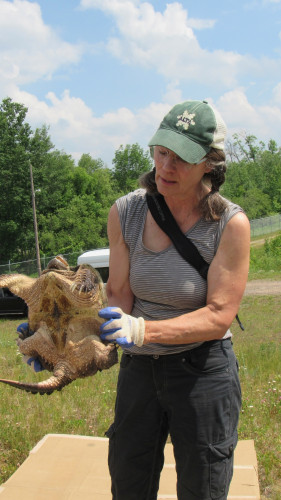
UW–Madison Forest and Wildlife Ecology Professor Anna Pidgeon demonstrates snapping turtle anatomy and safe handling during a visit to the Lac Courte Oreilles Fish Hatchery. Painted turtles and snapping turtles can get stuck in the rearing ponds at fish hatcheries because they can’t climb up the slippery plastic liners. Students released turtles removed from the ponds into a nearby river. Maria Moreno
“Spending time with the students and instructors in the field was an amazing experience,” says Carla Vigue, director of tribal relations at UW–Madison. “Our partnership with the Lac Courte Oreilles Ojibwe University and the College of Menominee Nation provides a unique learning experience for students. It was exciting to see how age-old Native traditions and cultural practices intersect with and often form the basis for so much science.”
Maria Moreno, faculty associate at Earth Partnership and DPLA, says collaborating on this field course provides valuable opportunities for CMN and LCOOU to work on an equal footing with UW–Madison.
“Their role in offering and hosting this course is important,” says Moreno. “They aren’t just on the sidelines. They are principal players in the organization and design of this course.”
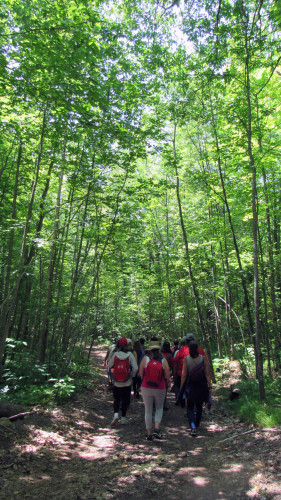
Students walk to Pipestone Creek, a ceremonial site for the Lac Courte Oreilles community. Special permission was given by the LCO Tribal Council to visit this revered and sacred place. Maria Moreno
The field course is open to eight students from each participating institution or Native nation. This year, most of the students identified as Native or Indigenous.
The opportunity to learn alongside other Native students is particularly valuable for Indigenous students at non-tribal universities. Kira Adkins, a member of the Oneida Nation and undergraduate legal studies major at UW–Madison, has participated in both years of the course. Adkins noted that students from the tribal land-grant institutions learn daily with students and instructors from their communities. Native students at UW–Madison must seek out these opportunities, however.
“When you’re constantly surrounded by students and instructors who have very similar experiences as you, and who come from the same background, I think it normalizes the intelligence that comes from those communities,” says Adkins. “Here, at UW–Madison, we have to search for it, so that you can get a little validation when you need it.”
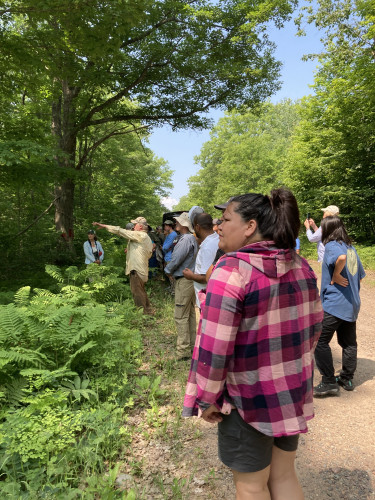
Bureau of Indian Affairs Forester Tim Johnson discusses forest management on land held by members of the Lac Courte Oreilles Tribe. Cris Carusi
The course planning team and instructors included faculty and staff from LCOOU, CMN and the UW–Madison Department of Forest and Wildlife Ecology, Data Science Institute and Earth Partnership. Indigenous students also participated in course instruction, with Adkins and UW–Madison student Angela Waupochick leading sessions on tribal land and resource management. Waupochick, a graduate student in forest and wildlife ecology, studies forest and wetlands conservation on Menominee and Stockbridge-Munsee tribal lands.
“By having Native partners participate and teach, you bring in Native ways of knowing,” says Moreno.
Cultural learning is important to Red Cliff Tribal Member Christie Branagan, who is working on her bachelor’s degree in human services at LCOOU. Branagan is interested in the connections between land stewardship and Native culture, and her experiences on the Chippewa Flowage and during other field visits throughout the week helped her integrate Indigenous and Western ways of understanding natural resources.
“On the flowage, we learned about water. In Ojibwe, nibi is water. Water is the life blood that flows through lakes, rivers and oceans. It plays an important role across faith-based traditions, not only here but worldwide,” says Branagan.
For Jeffery Vele Jr., a member of the Stockbridge-Munsee Community Band of Mohicans, integrating cultural learning with Western science is central to his career path. Vele is working toward a bachelor’s degree in sustainable agriculture at CMN. After completing his degree, he wants to help his community secure its food sovereignty through expanding local food production and reintroducing traditional crops. Like Adkins, Vele participated in both years of the field course.
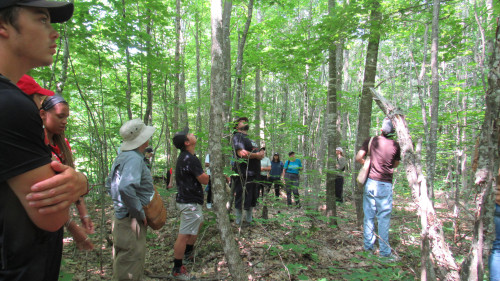
While learning about management practices in Lac Courte Oreilles forest stands, students experience the ecological, cultural and economic impacts of allotment, or the process of breaking tribally held lands into individually held parcels. Maria Moreno
“I think it’s important to learn about other First Nations, as a Native American,” says Vele. “We can learn from them and bring that back home to our tribe and practice their ways — the Native ways. Sharing ideas is really important.”
“I really appreciate how UW–Madison is reaching out and doing this whole program, and attempting to create a relationship with Native Americans,” Vele adds.
In June 2024, UW–Madison will host this field course in partnership with the Ho-Chunk Nation, LCOOU and CMN. Moreno is looking forward to the opportunity to visit locations in southern Wisconsin that are significant to Native people, from the effigy mounds on campus and at the UW Arboretum to land at the former Badger Army Ammunition Plant that has been returned to the Ho-Chunk Nation and renamed Maa Wákąčąk (Sacred Earth). Each year, organizing the field course has broadened Earth Partnership’s collaborations with First Nations and campus departments, and Moreno is excited to work with new partners for next summer’s course.
“Building these collaborations is the Wisconsin Idea in action — collaborating with others and bringing others’ experience to bear,” says Moreno.
This course was funded in part by the National Institute for Food and Agriculture New Beginnings for Tribal Students (2021-04748) and the Data Science Institute.




